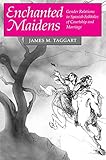Enchanted Maidens : Gender Relations in Spanish Folktales of Courtship and Marriage / James M. Taggart.
Material type: TextPublisher: Princeton, NJ : Princeton University Press, [2022]Copyright date: ©1990Description: 1 online resource (272 p.)Content type:
TextPublisher: Princeton, NJ : Princeton University Press, [2022]Copyright date: ©1990Description: 1 online resource (272 p.)Content type: - 9780691226927
- Courtship -- Spain -- Folklore
- Sex role -- Spain -- Folklore
- SOCIAL SCIENCE / Anthropology / General
- Aarne-Thompson tale type
- Ahigal
- Arroyomolinos
- Barrado
- Barry, Herbert III
- Bazagona
- Becedas
- Cabal, Constantino
- Cabezuela
- Christ
- Cortés Vázquez, Luis
- Cox, Marian Roalfe
- Donjuanismo
- Dundes, Alan
- Falassi, Alessandro
- García y Garcia, Segundo
- Grimms, the (brothers)
- Herzfeld, Michael
- Jaraíz de la Vera
- Lewis, Oscar
- Los Olivos
- Virgin Mary
- Zipes, Jack
- agrarian working class symbols
- agrotowns
- beauty: symbolism of
- bridal gift
- cannibals
- carnival
- dance groups
- defloration
- disenchantment
- eagle
- enchantment
- erotic aggression
- family structure
- feminism
- filial piety
- folklore
- forest
- gender segregation
- helpful characters
- idealization of women
- incest
- male competition
- mass media
- matrilocality
- menstrual magic
- thieves
- ugliness
- witchcraft
- 398/.355/0946 20
- GR230
- GR230 .T344 1990
- online - DeGruyter
| Item type | Current library | Call number | URL | Status | Notes | Barcode | |
|---|---|---|---|---|---|---|---|
 eBook
eBook
|
Biblioteca "Angelicum" Pont. Univ. S.Tommaso d'Aquino Nuvola online | online - DeGruyter (Browse shelf(Opens below)) | Online access | Not for loan (Accesso limitato) | Accesso per gli utenti autorizzati / Access for authorized users | (dgr)9780691226927 |
Frontmatter -- Contents -- List of Stories, Their Tellers, and Their Communities -- Preface -- 1. Introduction -- 2. The Context -- 3. "The Innocent Slandered Maiden" -- 4. Maidens and Thieves -- 5. "Snow White" -- 6. "Cinderella" -- 7. Disenchanting a Princess -- 8. The Animal Groom -- 9. "Blancaflor" -- 10. A Cross-Cultural Perspective -- 11. Conclusions -- Appendix: List of Supplementary Tales -- Notes -- Bibliography -- Index
restricted access online access with authorization star
http://purl.org/coar/access_right/c_16ec
Spanish villagers tell many folktales that describe in metaphorical language the struggles of young men and women as they emerge from their parental families and join in love. In this book James Taggart presents dozens of orally transmitted tales, including "Snow White," "Cinderella," "Beauty and the Beast," "Blancaflor," and dragonslayer stories, collected from seven villages in the region of CNBceres, and analyzes the differences in male and female approaches to telling them. His study shows how men and women use the tales to grapple with some of the contradictions found in gender relations in their culture, which conditions men to be sexually assertive and to marry virgins and which teaches women to fear the men who court them. Taggart interprets the male-female dialogue voiced through storytelling by linking the content of specific tales to the life experiences and gender of the storyteller. Men and women, he finds, carry out an exchange of ideas by retelling the same stories and altering the plots and characters to express their respective views of courtship. This indirect narrative dialogue conveys an understanding of the opposite sex and establishes a common model of marriage that permits men and women to overcome their fear of each other and bond in heterosexual love.
Mode of access: Internet via World Wide Web.
In English.
Description based on online resource; title from PDF title page (publisher's Web site, viewed 29. Jul 2022)


